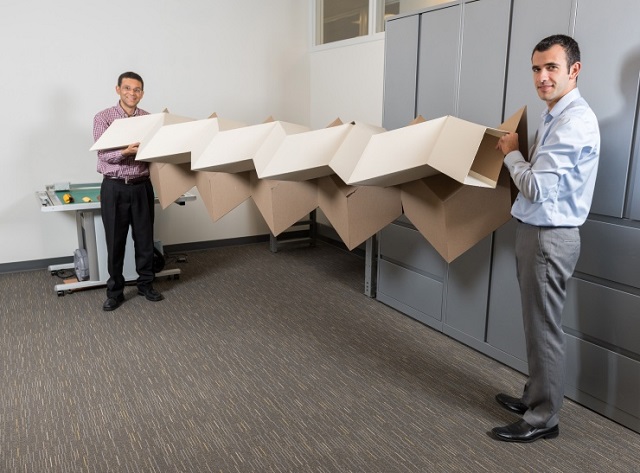 Researchers Glaucio Paulino (left) and Evgueni Filipov show a large origami structure that can be folded into a much smaller space. Filipov is from University of Illinois at Urbana-Champaign; Paulino is from the Georgia Institute of Technology. (Credit: Rob Felt, Georgia Tech)
Researchers Glaucio Paulino (left) and Evgueni Filipov show a large origami structure that can be folded into a much smaller space. Filipov is from University of Illinois at Urbana-Champaign; Paulino is from the Georgia Institute of Technology. (Credit: Rob Felt, Georgia Tech)
A study conducted by a team of researchers from the University of Illinois at Urbana-Champaign, the Georgia Institute of Technology and the University of Tokyo have created a unique “zippered tube” design to provide paper structures with enough stiffness to be able to hold weight yet able to be folded flat, thereby enabling easy storage and shipping.
Evgueni Filipov, Illinois graduate researcher, Glaucio Paulino, Georgia Tech professor and Tomohiro Tachi, University of Tokyo professor published their research findings in the September 7th issue of the journal Proceedings of the National Academy of Sciences.
This innovative technique can be used on other thin materials, such as metals or plastics, to alter a wide range of structures, including buildings, furniture and microscopic robots. The usefulness of origami structures is high in numerous everyday and engineering applications, such as a construction crane that can fold to hoist or deliver a load, a robotic arm that can stretch out, and scrunch up, or pop-up furniture.
According to Paulino, other potential applications could be emergency shelters, bridges and other infrastructures, which can be quickly assembled to handle a natural calamity.
Origami became more of an objective for engineering and a science just in the last five years or so. A lot of it was driven by space exploration, to be able to launch structures compactly and deploy them in space. But we’re starting to see how it has potential for a lot of different fields of engineering. You could prefabricate something in a factory, ship it compactly and deploy it on site.
Filipov
A specific origami method called Miura-ori folding was chosen by the researchers. Accurate, zig-zag folded paper strips were first created and then glued together to form a tube. Each paper strip is highly flexible, but as a tube, it exhibits stiffness and cannot be folded in as many directions.
Coupling of tubes into various configurations was performed by the researchers to check if that would increase the paper structure’s structural stiffness. They discovered that when two tubes are interlocked in zipper-like manner, the structure became harder and stiffer to bend or twist. In addition, the structure could be folded flat and expanded easily and swiftly to the original tube configuration.
The geometry is what really plays a role. We are putting two tubes together in a strange way. What we want is a structure that is flexible and stiff at the same time. This is just paper, but it has tremendous stiffness.
Paulino
The zipper design is applicable to tubes possessing varied folding angles. The researchers could create many types of 3D structures, such as a tower, a bridge or a canopy, by joining tubes with diverse geometries.
The ability to change functionality in real time is a real advantage in origami. By having these transformable structures, you can change their functionality and make them adaptable. They are reconfigurable. You can change the material characteristics: You can make them stiffer or softer depending on the intended use.
Filipov
Filipov stated that they chose to work with paper prototypes to show that thin, flexible sheets can be folded to form useful structures, and that the method used by them can be adapted to many other thin materials. In the case of larger-scale applications, plastic or metal panels could be combined with hinges.
Going forward, the team hopes to experiment with unique combinations of tubes with varied folding angles to construct novel structures. They are keen on adapting their technique for a range of applications, spanning from large-scale construction to microscopic structures for robotics or biomedical equipment.
All of these ideas apply from the nanoscale and microscale up to large scales and even structures that NASA would deploy into space. Depending on your interest, the applications I think are endless. We have just scratched the surface. Once you have a powerful concept, which we think the zipper coupling is, you can explore applications in many different areas.
Paulino
The research was supported by National Science Foundation.
References